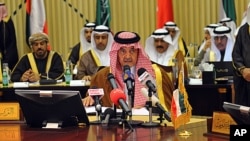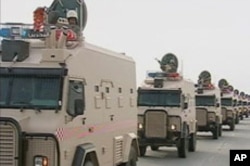The unrest in Syria highlights a larger struggle for regional influence between Iran and Saudi Arabia. Tthe tensions have been building as uprisings in the Arab world have pit the two on opposite sides of the conflicts.
Arab, Sunni-dominated Saudi Arabia and mainly Persian, Shi'ite Iran would seem destined to be at odds, facing off over the oil and gas rich Gulf. Relations grew worse following the U.S. war in Iraq, but have spiked further as they reacted to the past year's events across the region.
Tehran supported the uprisings in Tunisia and Egypt, while Saudi Arabia backed the governments. In Syria, support flips, with Iran working to keep the besieged Assad government in power and Saudi Arabia calling for the rebels to be better armed.
Researcher Nadim Shehadi of London-based Chatham House says the two nations are not alone in their seemingly contradictory approaches.
“The Arab uprisings have come as a surprise to everybody and none of the players have had a consistent policy, not even the United States or Europe or Russia," said Shehadi. "Because of the confusion there has always been the appearance of double standards.”
Among the standards not being used by Saudi Arabia and Iran, political analysts say, are the democratic rights of the oppressed. Both have dampened protests at home, mixing security crackdowns with pledges of increased government spending.
'Proxy confrontations'
A variety of tactics can also be seen in their support or opposition to groups across the region. Abdulaziz Sager, head of the Gulf Research Council, says Syria is just the most visible of the proxy confrontations in the region.
“Iran wanted to make sure that Iraq, Syria, Lebanon/Hezbollah, or what we call the Shi'ite Crescent, for them is quite important to offset the power of the other side of the Arab world, which is the Levant and the Gulf region. In reality today this is two blocs,” said Sager.
Those two blocs are reflected on the global stage, with the U.S. for the most part supporting the Saudi camp, and Russia siding with Iran. But Sager says it was not clear that Shi'ite leanings would guarantee the Syrian government choosing Tehran over Riyadh.
“Saudis historically have good relations with Syrians, but unfortunately the Syrians have not listened to the Saudi advice on the way they should have handled the clashes from the beginning,” said the head of the Gulf Research Council.
Tehran also appears to have gained the upper hand in a conflict right on Saudi Arabia's southern border. Northern Yemen rebels, the Shi'ite Houthis, have been increasing their areas of influence.
“It's not clear how much of the Houthi revolt is directly support by the Iranians," said Nadim Shehadi of Chatham House. "But wherever you have a Shi'ite-Sunni confrontation, or any variation of that, then you get the Iranian-Saudi rivalry manifesting itself.”
'A game-charger'
Another contentious area of Saudi and Iranian power plays is found in Bahrain, where Riyadh came to the aid of the Sunni government in putting down a popular uprising cast by some as sectarian unrest by disenfranchised Shi'ite groups.
Such maneuvering could, in theory, go on for years, but Shehadi says a game-changer looms. If Iran is close to developing nuclear weapons, as the West claims and Tehran denies, analysts like Shehadi say the effect on regional and global actions will be profound.
“If there is anything that happens in Bahrain, Abu Dhabi or Kuwait, the West will not be able to intervene and protect these countries in the same way," said Shehadi. "It will be like when the [Soviet] tanks rolled into Prague in 1968 and the West did nothing because the Soviet Union had nuclear weapons.”
Shehadi says Iran's nuclear potential could allow Tehran to treat any of the countries in the region much the way the Soviet Union used to treat Eastern Europe.
| Join the conversation on our social journalism site - Middle East Voices. Follow our Middle East reports on Twitter and discuss them on our Facebook page. |










